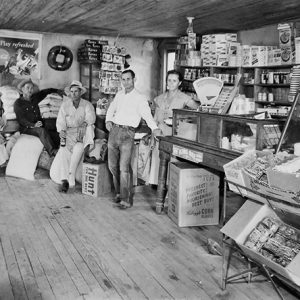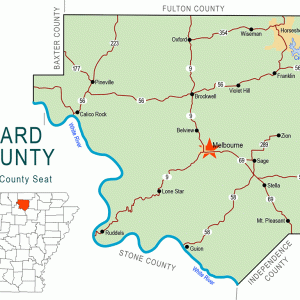calsfoundation@cals.org
Stella (Izard County)
Stella is located on Highway 69 about four and a half miles northwest of the center of Mount Pleasant (Izard County). The county seat, Melbourne (Izard County), is seven miles to the northwest. Within a radius of five miles are the hamlets of Sage, Bone Town, Gid, and Zion. The White River is about ten miles to the southwest. When Highway 69 was constructed in 1926, it bypassed the original Stella settlement. In the twenty-first century, Stella lies within the city limits of Mount Pleasant.
One of the pioneer trails into the interior of Izard County followed Polk Bayou (a.k.a. Poke Bayou) from Batesville (Independence County) northward and then traced Barren Fork Creek northwest toward present-day Melbourne. During the 1860s, a new trail was cut one mile south of the creek.
Brothers William and Hardy Davidson journeyed from Dyer, Tennessee, to Izard County during the Civil War period. William, with his wife and children, built a log cabin near a spot that came to be called Davidson Well, the original name for Stella. The family was noted as living there on the 1870 census. In 1873, a piece of Independence County was added to Izard County and called the Big Springs Township; this is where William Davidson and his family lived.
Abel Bone was in Izard County by 1842 and among the early settlers of what would become Bone Town. He married Sarah McKee in 1851 in Izard County, and they came to own 200 acres with about seventy-five under cultivation. Their son James Henry Bone eventually owned 180 acres with sixty under cultivation. He married Amanda Martha Taylor in 1878, and they had five children.
When the post office opened in 1894, James Henry Bone was appointed first postmaster. The community is believed to have been named by William Laban Davidson (a son of pioneer William Davidson), who became postmaster in 1897, for five-year-old Stella Meers. Stella was a close relative to Davidson’s wife, Dorcus Caldonia Alice Meers Davidson.
A small cemetery is located in Stella. The oldest grave identified in the cemetery belongs to Martha H. Arnold Taylor, who died in 1853; she was the first wife of Stephen Taylor, the father of Amanda Martha Taylor by his second wife. Martha’s stone is among the unmarked stone cairns believed to be the first graves in the burial site. Of the twenty-three marked graves, all but three have the family names of Bone or Taylor. The latest burial was in 2006. Abel and Sarah Bone were members of the Cumberland Presbyterian Church; their son’s family became Missionary Baptists.
Spring-fed Dodd Hole and Falls, named for Dodd Mill, which once stood at the site, was a popular swimming area for the Stella community and surrounding areas. It is on private property with limited access. The historic settlement where the mill stood was called Blye (a.k.a. Bly) and had a store with a post office (1911–1923), the mill, a blacksmith shop, and some houses. The foundation for the mill and remains of one of the houses are still visible. It was about a mile and a half from Stella. Father and son William J. F. and Thomas Franklin Vickery served as the first postmasters of Blye. Nancy Campbell was postmistress when the post office closed in 1923.
By the 1920s, Stella had become a booming community. W. H. and Dewey “Soup” Reeves had a store (with the post office inside) in the community in the late 1920s and early 1930s. Dewey served as postmaster of Stella from 1939 until 1943. Dave and Belle Reeves had a sawmill with a stave mill. There was also a blacksmith shop. But Stella’s proximity along a main highway to the growing hamlet of Mount Pleasant to the south and the county seat of Melbourne to the north prevented it from becoming a town of its own.
There was a Civilian Conservation Corps (CCC) camp on a hill on the west side of Highway 69 on the Eli Davidson place (Eli Davidson was a nephew to postmaster William Laban Davidson). Camp Sage, Company 3780, was built in 1937–38, holding from 175 to 200 people at its peak. Work done concerned forest husbandry and soil conservation—building forest roads (some later became county roads), stringing telephone lines, building a side camp, installing drainage control, and containing forest fires. A wooden fire watch tower was adjacent to the camp. Some of the CCC workers helped construct the courthouse in Melbourne. Camp Sage closed in November 1941. A few of the remains are still visible in the twenty-first century, and the land is still owned by the Davidson family.
A two-story private school named Mount Pleasant Academy was established in 1878 in Barren Fork, which attracted scholars from throughout the region, including Stella. Farmhouses were used for boarding pupils. The academy burned on January 10, 1905. In about 1909, a new building became the public school, replacing the one that had burned. The children in Stella later attended the Mount Pleasant public school, which was annexed to Melbourne on July 1, 2004.
Manganese found south of Stella, especially in the Cushman/Bethesda regions just across the county line in Independence County, played a role in Stella’s economic life, as did sand used in natural gas exploration. Between 1952 and 1958, the federal government initiated a policy to stockpile manganese, which was considered of importance to national security as a significant alloy in making steel. This created an economic boom for the area during the 1950s. By this time, advances in technology allowed strip-mining using heavy equipment instead of old methods of shafts and tunnels. The last ore was mined in the Batesville District, as this region was called, in 1959, when the federal government phased out its national security program of stockpiling manganese, which officially ended in 1960; steel makers in the United States started depending on imported ore.
The post office closed in 1955. State Highway 69 between Batesville and Melbourne was paved during 1952–53, and a city water system was completed for nearby Mount Pleasant in the late 1960s. Everett Roberts, mayor of Mount Pleasant, petitioned landowners along Highway 69 to become part of the city so they could qualify for the water system. Stella thus became a part of Mount Pleasant.
Although small farms continue to exist, cattle and poultry production have become part of the economic well-being of Stella. Many who reside in the area hold jobs in Melbourne and Batesville. Cornerstone Baptist Church, Concord Church, and the Macedonia Church near Stella are active in the twenty-first century. A small private airfield known as Davidson Field is located in Stella.
For additional information:
Shannon, Karr. A History of Izard County. Little Rock: Democrat Printing & Lithographing, 1947.
Ogilvie, Craig. “A History of Barren Fork.” Izard County Historian 17 (January 1986): 12–20.
Smith, Jim, and Becky Wood. The Cushman Manganese Mines and the Batesville Manganese District Arkansas. N.p.: 1995.
Kenneth Rorie
Van Buren, Arkansas
 Dewey Reeves Store
Dewey Reeves Store  Dodd Hole and Falls
Dodd Hole and Falls  Izard County Map
Izard County Map  Reeves Store/Post Office
Reeves Store/Post Office 




Comments
No comments on this entry yet.